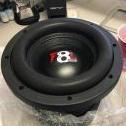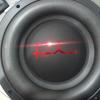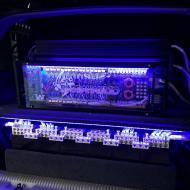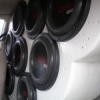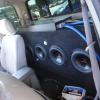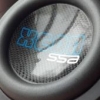Leaderboard
Popular Content
Showing content with the highest reputation on 12/29/2011 in all areas
-
2 pointsKerfing 101- UNDER CONSTRUCTION What is Kerfing? “Kerf” by definition means “width of a saw cut”. This is the width of the actual saw tooth itself as opposed to the width of the blade as a saw tooth flares out and away from a blade. “Kerfing” is a term that many woodworkers have adopted to define the process of making several cuts within a piece of wood to achieve the removal of material. Often this removal of material will allow one to then bend the wood stock making a nice professional and appealing curve that can be incorporated into the project. Kerfing and Car Audio: What can Kerfing do for you in your quest of car audio domination? Well first of all it is important to note that in any ported subwoofer box hard corners are the devil. They do not allow efficient air flow which can result in less output and more port noise. Kerfing your port will allow you to maximize efficiency and create the most non-turbulent flow for the air moving in and out of the enclosure. Secondly Kerfing can be used to make an enclosure or other part of your build more appealing to the eye. You could use it for corners of an amp rack, or to make a custom arm rest more smooth. Kerfing is a process you need to learn to take your builds to the next level. What you need: This is outlined in the video but you will need the following (* means you don’t HAVE to have it but it is recommended): Circular Saw (Or table saw but the process will differ from the video) Disclaimer: My Saw blade is 1/8” wide. I recommend the same width! T-Square (Or table saw fence) MDF Wood Glue Safety Glasses Tape Measure Marker/Pencil Clamps Fiberglass Resin* Fiberglass Chop Mat* Body Filler* Sand Paper* The steps: Watch the video! Once the kerfed section is made load it up with wood glue and clamp it in place. Finish with fiberglass resin and chop mat and for that added professional touch apply body filler to the area and sand! The Math: I go through the math in the video but in case you are having a hard time understanding this should help. Please note this is used for slot porting applications so when I reference “diameter” I am NOT talking about a circular port, I am talking about the curve of the kerf if you were to look at it along its cross section. See the photo below: Step 1: Determine the diameter of your curve. Note I said “Diameter NOT radius” if you have your radius just multiply it by 2 and you now have your diameter). Step 2: Find the circumference of a circle using this diameter. The equation is: Step 3: You should now have a value for your circumference. Take this value and divide by 4 for a 90 degree turn or 2 for a 180 degree turn, this will give you the “length of kerf”. Step 4: Record your value for the length of the kerf. This is how much material along your mdf “linearly” must be used to make your curved kerfed section. This is the value you want to “mark off’ for your kerf on the mdf. (Note that this method can also be used to find the “length” of this part of your port so that you can build your port to the target tuning length. Instead of using the diameter of your kerf arc, use the diameter of the arc that is the centerline of the port). Step 5: Now that you have marked off where your kerf will be on the mdf you are going to take your “length of kerf value” and divide it by 12. This will give you your length between cuts. Now in the video I show a trick for making these divisions perfect. That way if your value is something like .6384 you don’t have to guess on a tape measure. My method is also much faster as it doesn’t require this steps math. Once you have marked out all the distances between cuts you can proceed with cutting and making your kerfs! Other notes: These are other notes that have been brought up on other forums and I feel are helpful. I made the mistake of wearing gloves in the video. Never wear gloves with rotary tools! It is not recommended to apply screws in the kerfed section of the mdf, it will likely split, instead use clamps (or heavy objects) and wood glue. If you are blade in not 1/8 you will need to do some math to determine how many cuts to make. I generally remove an inch and a half of material, so if your blade is smaller, more cuts, wider, less cuts. Note that fewer cuts will lead to a rougher curve and more a smoother curve but with less strength. Pictures: Design of an enclosure using a Kerfed Port: Box with Kerfed Port: (Picture to come) Box with kerfed port and kerfed exit of port: (Picture to come) Made this video to show how to Kerf, enjoy!
-
2 pointsi wish i couod edit the first post! this is what i want it to show! Kerfing 101- UNDER CONSTRUCTION What is Kerfing? “Kerf” by definition means “width of a saw cut”. This is the width of the actual saw tooth itself as opposed to the width of the blade as a saw tooth flares out and away from a blade. “Kerfing” is a term that many woodworkers have adopted to define the process of making several cuts within a piece of wood to achieve the removal of material. Often this removal of material will allow one to then bend the wood stock making a nice professional and appealing curve that can be incorporated into the project. Kerfing and Car Audio: What can Kerfing do for you in your quest of car audio domination? Well first of all it is important to note that in any ported subwoofer box hard corners are the devil. They do not allow efficient air flow which can result in less output and more port noise. Kerfing your port will allow you to maximize efficiency and create the most non-turbulent flow for the air moving in and out of the enclosure. Secondly Kerfing can be used to make an enclosure or other part of your build more appealing to the eye. You could use it for corners of an amp rack, or to make a custom arm rest more smooth. Kerfing is a process you need to learn to take your builds to the next level. What you need: This is outlined in the video but you will need the following (* means you don’t HAVE to have it but it is recommended): Circular Saw (Or table saw but the process will differ from the video) Disclaimer: My Saw blade is 1/8” wide. I recommend the same width! T-Square (Or table saw fence) MDF Wood Glue Safety Glasses Tape Measure Marker/Pencil Clamps Fiberglass Resin* Fiberglass Chop Mat* Body Filler* Sand Paper* The steps: Watch the video! Once the kerfed section is made load it up with wood glue and clamp it in place. Finish with fiberglass resin and chop mat and for that added professional touch apply body filler to the area and sand! The Math: I go through the math in the video but in case you are having a hard time understanding this should help. Please note this is used for slot porting applications so when I reference “diameter” I am NOT talking about a circular port, I am talking about the curve of the kerf if you were to look at it along its cross section. See the photo below: Step 1: Determine the diameter of your curve. Note I said “Diameter NOT radius” if you have your radius just multiply it by 2 and you now have your diameter). Step 2: Find the circumference of a circle using this diameter. The equation is: Step 3: You should now have a value for your circumference. Take this value and divide by 4 for a 90 degree turn or 2 for a 180 degree turn, this will give you the “length of kerf”. Step 4: Record your value for the length of the kerf. This is how much material along your mdf “linearly” must be used to make your curved kerfed section. This is the value you want to “mark off’ for your kerf on the mdf. (Note that this method can also be used to find the “length” of this part of your port so that you can build your port to the target tuning length. Instead of using the diameter of your kerf arc, use the diameter of the arc that is the centerline of the port). Step 5: Now that you have marked off where your kerf will be on the mdf you are going to take your “length of kerf value” and divide it by 12. This will give you your length between cuts. Now in the video I show a trick for making these divisions perfect. That way if your value is something like .6384 you don’t have to guess on a tape measure. My method is also much faster as it doesn’t require this steps math. Once you have marked out all the distances between cuts you can proceed with cutting and making your kerfs! Other notes: These are other notes that have been brought up on other forums and I feel are helpful. I made the mistake of wearing gloves in the video. Never wear gloves with rotary tools! It is not recommended to apply screws in the kerfed section of the mdf, it will likely split, instead use clamps (or heavy objects) and wood glue. If you are blade in not 1/8 you will need to do some math to determine how many cuts to make. I generally remove an inch and a half of material, so if your blade is smaller, more cuts, wider, less cuts. Note that fewer cuts will lead to a rougher curve and more a smoother curve but with less strength. Pictures: Design of an enclosure using a Kerfed Port: Box with Kerfed Port: (Picture to come) Box with kerfed port and kerfed exit of port: (Picture to come)
-
1 pointvideo is good... As far as all of the JL Audio hating, I just don't get it. We have used many many many JL Audio subwoofers over the years, and they do make a very good product. They are expensive yes, but Ferarri's are expensive also, but is that a great reason to hate on them? I donno... I wouldn't complain if my car or truck was full of W7's... just my thoughts...
-
1 pointA Guy Goes To The U.s. Post Office To Apply For A Job And The Interviewer Asks Him, "have You Been In The Service?" "yes," He Says. "i Was In Vietnam For Three Years" The Interviewer Says, "that Will Give You Extra Points Toward Employment", And Asks, "are You Disabled In Any Way?" The Guys Says, " Yes 100% ... A Mortar Round Exploded Near Me And Blew My Testicles Off". The Interviewer Tells The Guy, "ok I Can Hire You Right Now. The Hours Are From 8 Am To 4 Pm. You Can Start Tomorrow. Come In At 10 Am." The Guy Is Puzzled And Says, "if The Hours Are From 8 Am To 4 Pm, Then Why Do You Want Me To Come In At 10 Am? "this Is A Government Job. For The First Two Hours We Stand Around Scratching Our Balls ... No Point In You Coming In For That."
-
1 pointHow well is your door installation ?? meaning Sound Deadning through out ?? seal all the air openings ?? any foam to help prevent air leaks ???
-
1 pointMy little brother standing on the first baffle so the holes can be cut out. Sanding port smooth Jesus, that's a tight fit. Leveled out and looking pretty. Fog light HID's and LED Switchback blinkers on the way.
-
1 point
-
1 pointyou dont have a dick to be on son get that gay shit out of here i dont get ripped off dont get mad cuz your shits super fucking weak and you cant make a fucking box to save your life .you done a bitch move you fucking pussy Hehe, Support the 300% profit margin.
-
1 point
-
1 point
-
1 pointNow I have no ZCON but the two local audio dealers here love my DCON 10" and are amazed at how great it sounds and the output it has for a low wattage sub woofer. I can see ZCONS in my future.
-
1 point
-
1 pointhttp://www.eclipse-web.com/us/download/manual/cd7200mkII_e/audio/contents/1636.html
-
1 pointJust to add to this, the amount of cuts depends not only on the degree of the bend you desire, but the blade thickness. A thin kerf blade will require more cuts than a 1/8" wide blade. i have a calculator i made in excel that i will upload later that only works with 1/8" wide blades. you just input the desired radius and the degree of bend and it gives you all the info you need. edit: it can be downloaded here
-
1 point
-
1 pointDrew stop being a hater, Bo agreed with it too. Not being a hater. Mine just does better hair tricks. I bet your E-penis is bigger too. I'M happy that's ALL that matters.
-
0 pointsDO NOT DO REAR SPEAKERS! It is a complete waste! You should focus on your front stage not some rear speaker garbage.
-
0 pointsno shit you had 6 12's The sad thing is the single 18" quality woofer is louder.
-
-1 points
-
-1 points
-
-1 pointsno shit you had 6 12's The sad thing is the single 18" quality woofer is louder. doing 150+'s now after adjusting internal volume and subsequently raising tuning.
-
-1 pointsDude get off my dick we know Kevin's dick is up your Ass. I hope you love getting ripped off.
-
-1 points
-
-1 pointstrying to sell this beast amp will get a pic with name later today trying to get 120shipped o.b.o this is a saz1000d Uploaded with ImageShack.us this is my usa made planet audio p850d Uploaded with ImageShack.us
-
-2 points




